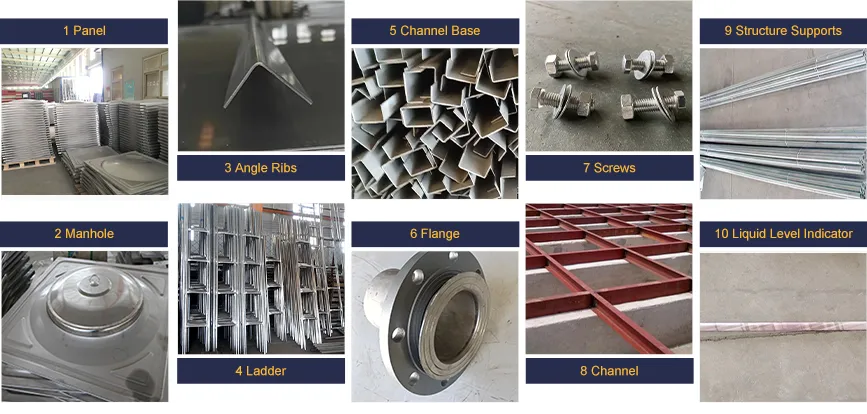loading...
- No. 9, Xingyuan South Street, Dongwaihuan Road, Zaoqiang County, Hengshui, Hebei, China
- admin@zjcomposites.com
- +86 15097380338
- Welcome to visit our website!
Design and Functionality of Sectional Water Storage Tanks for Efficient Water Management
Sectional Water Tanks A Comprehensive Overview
Sectional water tanks have emerged as a versatile solution for water storage needs across various applications. These tanks are constructed in sections, which allows for easier transportation, assembly, and customization according to specific requirements. As urbanization and industrialization continue to rise, the demand for efficient and reliable water storage solutions becomes increasingly critical. This article delves into the characteristics, advantages, applications, and maintenance of sectional water tanks.
Characteristics of Sectional Water Tanks
Sectional water tanks are typically made from robust materials such as fiberglass, stainless steel, or reinforced concrete, which provide durability and resistance to environmental factors. The sections are prefabricated and manufactured off-site, which minimizes on-site construction time. This modular approach not only reduces labor costs but also allows for flexibility in design and capacity.
The capacity of sectional water tanks can vary significantly, ranging from small tanks suitable for residential use to large installations for commercial and industrial purposes. The sections can be easily configured and scaled up or down, enabling users to meet changing water storage demands without the need for completely new tanks. Additionally, many designs incorporate insulation features or coatings to protect the stored water from temperature fluctuations and contamination.
Advantages of Sectional Water Tanks
One of the primary advantages of sectional water tanks is their ease of installation. Since they are delivered in sections, they are easier to transport, especially in urban areas or locations with restricted access. The simplicity of assembly allows for quicker installation compared to traditional tanks, facilitating prompt water management solutions.
Moreover, sectional water tanks are highly customizable
. Users can adjust the size, shape, and configuration based on geographical and environmental considerations, making it an ideal choice for varied terrains and climates. This adaptability makes sectional water tanks suitable for both temporary and permanent installations.Another key benefit is their maintenance efficiency. Most sectional tanks are designed with accessibility in mind, allowing for easy inspection and cleaning. Their materials are often resistant to corrosion, minimizing long-term maintenance costs. Furthermore, sectional tanks contribute to water conservation as they can be designed to minimize evaporation and leakage.
sectional water tank

Applications of Sectional Water Tanks
Sectional water tanks have a wide range of applications across different sectors. In residential areas, they are commonly used for water storage in homes, particularly in regions where municipal water supply may be unreliable. In agricultural settings, these tanks enable the efficient collecting and storing of rainwater for irrigation and livestock use.
In industrial applications, sectional water tanks serve as essential components for fire safety systems, cooling processes, and as part of water treatment facilities. Public infrastructure, such as parks and recreational areas, also employs sectional water tanks for irrigation and landscaping purposes.
Maintenance of Sectional Water Tanks
To ensure longevity and optimal performance, regular maintenance of sectional water tanks is crucial. Routine inspections should be conducted to check for any signs of wear or damage. Cleaning schedules should also be established to prevent the buildup of algae and sediment, which can compromise water quality.
It is essential to monitor the seals and joints of the sectional tank to prevent leaks. If any structural issues are detected, timely repairs should be performed to avoid larger problems in the future. Additionally, implementing water quality testing can help ensure that the stored water remains safe for its intended use.
Conclusion
Sectional water tanks represent a practical and efficient solution for various water storage needs. Their modular design, durability, and customizable nature make them an attractive option for residential, agricultural, industrial, and public applications. As water scarcity becomes an increasingly pressing issue globally, investing in reliable and sustainable water storage solutions like sectional water tanks is vital for effective water management moving forward. In understanding their characteristics, advantages, applications, and maintenance, stakeholders can make informed decisions that promote both efficiency and sustainability in water usage.
-
The Rise of FRP Profiles: Strong, Lightweight, and Built to LastNewsJul.14,2025
-
SMC Panel Tanks: A Modern Water Storage Solution for All EnvironmentsNewsJul.14,2025
-
GRP Grating: A Modern Solution for Safe and Durable Access SystemsNewsJul.14,2025
-
Galvanized Steel Water Tanks: Durable, Reliable, and Ready for UseNewsJul.14,2025
-
FRP Mini Mesh Grating: The Safer, Smarter Flooring SolutionNewsJul.14,2025
-
Exploring FRP Vessels: Durable Solutions for Modern Fluid HandlingNewsJul.14,2025
-
GRP Structures: The Future of Lightweight, High-Performance EngineeringNewsJun.20,2025
